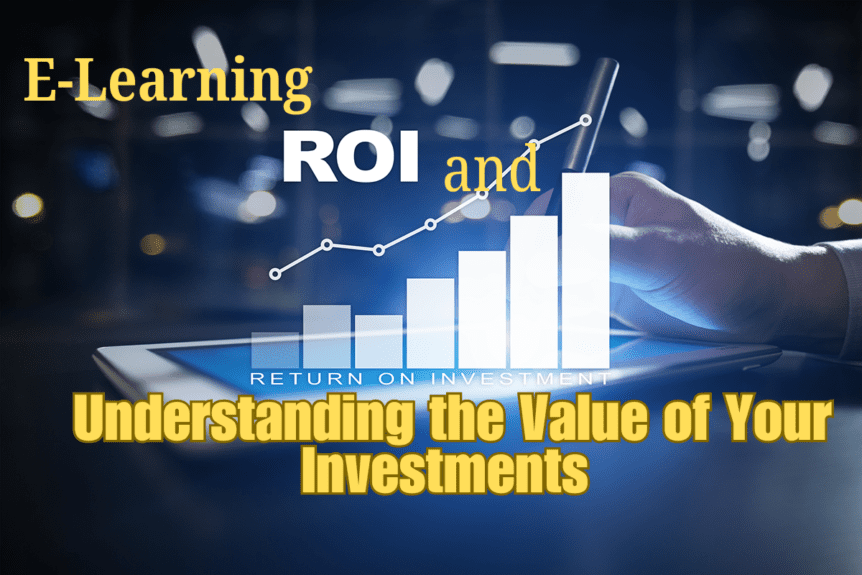E-Learning ROI and Understanding the Value of Your Investments
Developing and delivering training to your team requires an investment. There are costs involved with training and there are goals and objectives you want to achieve. How should you assess e-learning return on investment (ROI)? How do you get a true understanding of the value created by your investments in e-learning?
Value Versus ROI
A good starting point is to consider the difference between value and ROI. ROI can be viewed as a straightforward financial calculation:
- ROI (%) = [(Monetary benefits – Training Costs)]/Training Costs * 100
Monetary benefits could be increased sales or increased productivity. These are known as quantitative measurements as they are objective and can be assigned a monetary value.
However, there are also qualitative benefits of training and e-learning such as employee satisfaction or certain types of behavioural change. The impact of these types of benefits is subjective and it is difficult, if not impossible, to assign a monetary value.
Therefore, it is also important to get an understanding of the value of your e-learning investments as a whole. Where ROI calculations are possible, they are worthwhile, but you should also look at the full picture.
Other Challenges of Measuring E-Learning ROI
There are also other challenges that impact measurements and evaluations of e-learning ROI. We have already talked about the qualitative benefits above. They can also be described as intangible benefits, but that shouldn’t detract from their importance. Even though they are intangible in a monetary sense, they still have an impact on the business.
Some of the other challenges you should consider when measuring e-learning ROI include:
Isolating Training Activities
Training doesn’t exist in your organisation in isolation. This means there are a range of other factors that can influence the impact of your e-learning course. For example, key employees could leave the business for reasons unrelated to the training, limiting the performance improvements you expected the training to deliver.
Lack of opportunity is another factor that could limit the impact of your e-learning course. For example, you could train employees on a new machine or software application but there could be problems with the installation of the machine or software that prevents the employee from putting their training into practice.
Linking Training to Performance and Outcomes
Another challenge is accurately linking training to performance and outcomes. For example, you could deliver a sales-related e-learning course where one of the objectives is to increase sales. How do you link any subsequent increase in sales directly to the training, i.e., what proportion of the increase in sales is a result of the training and not because of monetary incentives, management direction, or simply being in the right place at the right time?
Inconsistent Framework
Another challenge when measuring e-learning ROI is the lack of a consistent framework. This inconsistency means ROI calculations can differ from course to course.
Lack of Data
A lack of data can also be a problem. A good quality LMS will give you some data, but you are also likely to need business and KPI data. That sort of data is not always as available, complete, or accurate as it could be.
Why Measure ROI and the Value of Your E-Learning Investments?
- Justify spending – most ROI calculations in business are about justifying spending. The same can apply to e-learning, where you demonstrate how the business benefited from the training financially and in other ways.
- Get buy-in – getting buy-in for future investments is another important objective of understanding e-learning ROI and value. By demonstrating the impact of previous courses, you can also get senior managers and other stakeholders on board with your wider training strategy.
- Improve performance – understanding the value of e-learning ROI can also help you identify areas that can be improved. This includes parts of the course or overall strategy that didn’t deliver to the level you anticipated. You can use this information to improve existing e-learning courses as well as future projects.
- Understand the impact – the best training courses are designed to have an impact, i.e., improve business performance, enhance critical KPIs, reduce risks, etc. Assessing ROI and the value derived from your e-learning courses will help you get a complete overview of the impact.
- Identify knowledge gaps – measuring ROI and the impact of your e-learning courses will help identify persistent knowledge gaps in the organisation. This information can be used when making decisions on future e-learning development projects.
- Improve the impact – ROI calculations and value assessments can also help you understand where you might be able to improve the impact of your training initiatives. Examples include communication around the e-learning course and post-implementation activities.
- Enhance training strategy – ROI calculations and value assessments on completed and delivered e-learning courses can also be used to analyse and refine your training strategy.
- Prioritise future initiatives – you can also get a clearer picture of what you should do next when you have a good understanding of ROI and e-learning value.
Achieving ROI From Your E-Learning Investments
One of the aims of e-learning development projects is to be successful. Understanding that success means calculating ROI when it is possible to do so, as well as getting a full understanding of the value of your e-learning investments. There are challenges in conducting this analysis, but it will be beneficial to your training strategy, the learner experience, and your overall business.
